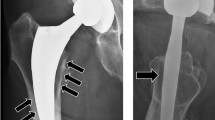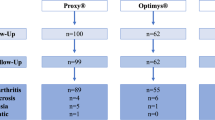Abstract
Purpose
To evaluate the influence of short versus long stems implanted through a Direct Anterior Approach (DAA) on clinical and radiological outcomes in THA at medium-term follow-up (average follow-up of 44.8 months).
Methods
167 consecutive total hip arthroplasties treating patients affected by primary hip osteoarthritis were retrospectively evaluated. A standard-length stem (H-MAXs) was used in 70 patients, while a short metaphyseal—fitting femoral stem (MINIMA) was used in 97 patients. The Harris Hip Score (HHS) and Forgotten Joint Score-12 (FJS) were used as outcomes measurements. Post-operatively, Engh’s score and Brooker classification were analyzed at 6 months, 1 year and every 2 years until the final FU. The correct size of the implant was evaluated determining the canal fill index (CFI), and all undersized stems were classified according to Magra classification.
Results
The average HHS was 83 ± 13.4 in the standard stems group and 87 ± 14.1 for short stems group (p = 0.148). The average FJS was 87.9 ± 15.2 for patients in the standard stems group and 84.5 ± 17.7 with no significant differences (p = 0.327). None of the stems showed radiographic signs of instability (standard stems mean Engh’s score: 19.25 versus short stems mean Engh’s score: 19.50—p = 0.41). According to Brooker classification, no significant difference in severity was found using different stems (p = 0.715). A high rate of undersized stems was found (standard stems 24%—short stems 25%) but without statistical difference between groups (p = 0.078), while a different trend in malposition following the recent classification proposed by Magra et al. was observed evaluating all undersized stems (p = 0.0387).
Conclusions
Both groups achieved good and comparable patient-reported outcome measurements (PROMs) and radiographic stability with fixation observed by bone ingrowth. A high rate of undersized stems was found with a correlation between femoral stem length and specific pattern of malposition. Malalignment in Varus was frequent in shorter stems in contact proximally with medial calcar and distally with lateral cortex, while a uniform undersizing was observed for longer ones with a continuous margin around the stem. However, the stems never presented progressive radiolucent lines over the whole surface of the stem.



Similar content being viewed by others
References
Sloan M, Premkumar A, Sheth NP (2018) Projected volume of primary total joint arthroplasty in the U.S., 2014 to 2030. J Bone Jt Surg Am 100:1455–1460. https://doi.org/10.2106/JBJS.17.01617
Kurtz SM, Lau E, Ong K et al (2009) Future young patient demand for primary and revision joint replacement: national projections from 2010 to 2030. In: Clinical orthopaedics and related research. Springer, New York, pp 2606–2612
Grieco PW, Pascal S, Newman JM et al (2018) New alternate bearing surfaces in total hip arthroplasty: a review of the current literature. J Clin Orthop Trauma 9:7–16
Meermans G, Konan S, Das R et al (2017) The direct anterior approach in total hip arthroplasty a systematic review of the literature. Bone Jt J 99B:732–740
Christensen CP, Jacobs CA (2015) Comparison of patient function during the first six weeks after direct anterior or posterior total hip arthroplasty (THA): a randomized study. J Arthroplasty 30:94–97. https://doi.org/10.1016/j.arth.2014.12.038
Abe H, Sakai T, Takao M et al (2015) Difference in stem alignment between the direct anterior approach and the posterolateral approach in total hip arthroplasty. J Arthroplasty 30:1761–1766. https://doi.org/10.1016/j.arth.2015.04.026
Vaughan PD, Singh PJ, Teare R et al (2007) Femoral stem tip orientation and surgical approach in total hip arthroplasty. HIP Int 17:212–217. https://doi.org/10.5301/HIP.2008.3618
Newman EA, Holst DC, Bracey DN et al (2016) Incidence of heterotopic ossification in direct anterior vs posterior approach to total hip arthroplasty: a retrospective radiographic review. Int Orthop 40:1967–1973. https://doi.org/10.1007/s00264-015-3048-4
Post ZD, Orozco F, Diaz-Ledezma C et al (2014) Direct anterior approach for total hip arthroplasty: Indications, technique, and results. J Am Acad Orthop Surg 22:595–603
Galakatos GR (2018) direct anterior total hip arthroplasty. Missouri State Medical Association
Brooker AF, Bowerman JW, Robinson RA, Riley LH Jr (1973) Ectopic ossification following total hip replacement. Incidence and a method of classification. J Bone Jt Surg Am 55:1629–1632
Engh CA, Bobyn JD, Glassman AH (1987) Porous-coated hip replacement. The factors governing bone ingrowth, stress shielding, and clinical results. J Bone Jt Surg Br 69:45–55
Hwang KT, Kim YH, Kim YS, Choi IY (2012) Total hip arthroplasty using cementless grit-blasted femoral component. A minimum 10-year follow-up study. J Arthroplasty 27:1554–1561. https://doi.org/10.1016/j.arth.2012.02.005
Magra M, McConnell J, … FS-O (2018) Undefined a classification system for undersized femoral stems in uncemented hip arthroplasty. online.boneandjoint.org.uk
Maldonado DR, Kyin C, Walker-Santiago R et al (2019) Direct anterior approach versus posterior approach in primary total hip replacement: comparison of minimum 2-year outcomes. HIP Int. https://doi.org/10.1177/1120700019881937
Barrett WP, Turner SE, Leopold JP (2013) Prospective randomized study of direct anterior vs postero-lateral approach for total hip arthroplasty. J Arthroplasty 28:1634–1638. https://doi.org/10.1016/j.arth.2013.01.034
Frye BM, Berend KR, Lombardi AV et al (2015) Do sex and BMI predict or does stem design prevent muscle damage in anterior supine minimally invasive THA? Clin Orthop Relat Res 473:632–638. https://doi.org/10.1007/s11999-014-3991-1
Lect CD-IC, 1995 undefined Fractures of the femur after hip replacement. ci.nii.ac.jp
Miller LE, Gondusky JS, Kamath AF et al (2018) Influence of surgical approach on complication risk in primary total hip arthroplasty: systematic review and meta-analysis. Acta Orthop 89:289–294. https://doi.org/10.1080/17453674.2018.1438694
Eggli S, Rodriguez J, Belgica RG-AO (2000) Undefined Heterotopic ossification in total hip arthroplasty: the significance for clinical outcome. ncbi.nlm.nih.gov
Kutzner KP, Hechtner M, Pfeil D et al (2017) Incidence of heterotopic ossification in minimally invasive short-stem tha using the modified anterolateral approach. HIP Int 27:162–168. https://doi.org/10.5301/hipint.5000448
Molli RG, Lombardi A V., Berend KR et al (2012) A short tapered stem reduces intraoperative complications in primary total hip arthroplasty. In: Clinical orthopaedics and related research. Springer, New York, pp 450–461
Rivera F, Leonardi F, Evangelista A, Pierannunzii L (2016) Risk of stem undersizing with direct anterior approach for total hip arthroplasty. HIP Int 26:249–253. https://doi.org/10.5301/hipint.5000337
Kutzner KP, Freitag T, Bieger R (2020) Defining ‘undersizing’ in short-stem total hip arthroplasty: the importance of sufficient contact with the lateral femoral cortex. HIP Int. https://doi.org/10.1177/1120700020940276
Author information
Authors and Affiliations
Corresponding author
Ethics declarations
Conflict of interest
Each author declares that he or she has no commercial associations (e.g., consultancies, stock ownership, equity interest, patent/licensing arrangement, etc.) that might pose a conflict of interest in connection with the submitted article.
Ethical approval
Ethical approval was waived for the retrospective nature of the study.
Consent to participate and consent for publication
All patients provided written informed consent to participate in the study and for the publication of the results.
Additional information
Publisher's Note
Springer Nature remains neutral with regard to jurisdictional claims in published maps and institutional affiliations.
Rights and permissions
Springer Nature or its licensor holds exclusive rights to this article under a publishing agreement with the author(s) or other rightsholder(s); author self-archiving of the accepted manuscript version of this article is solely governed by the terms of such publishing agreement and applicable law.
About this article
Cite this article
Risitano, S., Piccato, A., Fusini, F. et al. Direct anterior approach in total hip arthroplasty: influence of stem length on clinical and radiological outcomes at medium-term follow-up. Musculoskelet Surg 107, 305–311 (2023). https://doi.org/10.1007/s12306-022-00758-7
Received:
Accepted:
Published:
Issue Date:
DOI: https://doi.org/10.1007/s12306-022-00758-7




